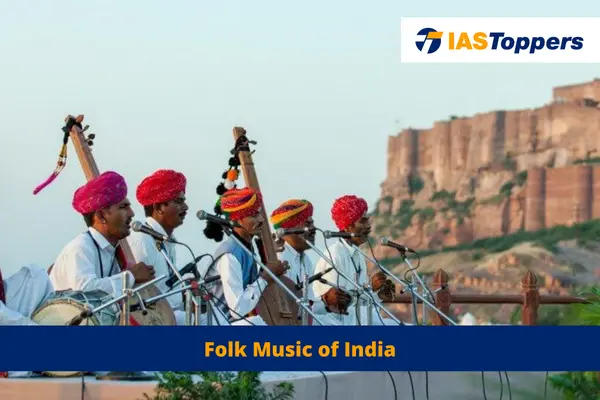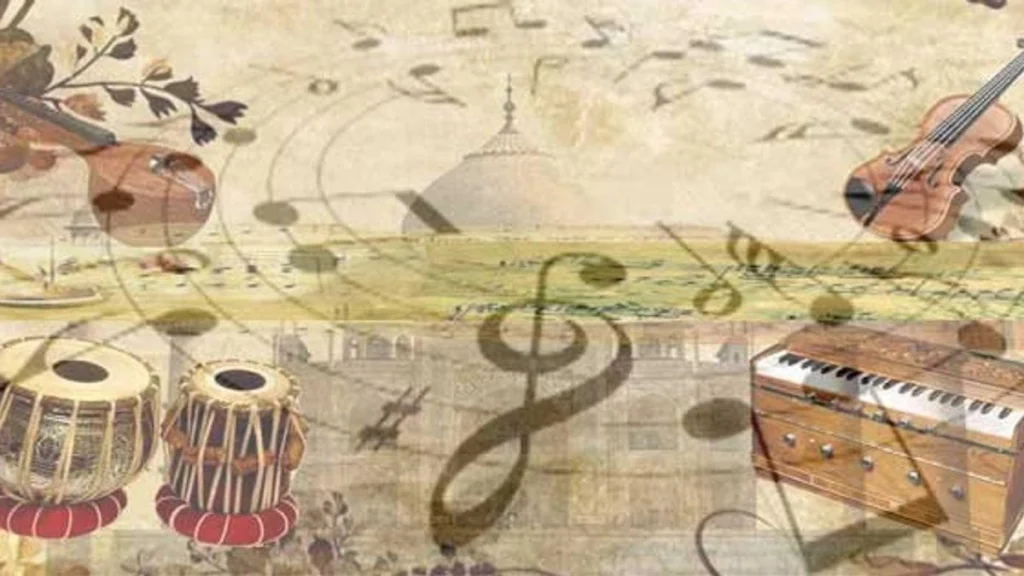Folk Music of India serves as a reflection of the emotions and sentiments of the masses. Folk songs represent the essence of various life events such as festivals, changing seasons, marriages, and the birth of a child. Folk Music is often designed dance-friendly, incorporating lively beats that invite movement.
Folk Music of India will be helpful for UPSC IAS Exam preparation. GS Paper-1 Art and Culture.
Table of Content
- Folk Music of India
- List of Indian Folk Music
- Important Folk Music of India
- Conclusion
- Frequently Asked Questions (FAQs)
Folk Music of India
- Folk music emerges organically from the people, devoid of rigid regulations. While classical music adheres to the rules outlined in the Natyashastra and follows the revered guru-shishya tradition.
- In addition to classical music, India boasts a diverse heritage of folk or popular music, which serves as a reflection of the emotions and sentiments of the masses.
- These songs, with their simplicity, encapsulate the essence of various life events such as festivals, changing seasons, marriages, and the birth of a child.
- Folk songs carry unique meanings and messages, often narrating historical events and significant rituals.
- Folk music in India encompasses a wide range of themes and is characterized by its vibrant rhythmic patterns.
- It is often designed to be dance-friendly, incorporating lively beats that invite movement.
- Every state boasts its own distinctive forms of folk music, each with its distinct identity and cultural significance.
List of Indian Folk Music
Some of the prominent Indian Folk Music and its respective states are mentioned below:
| Folk Music | State |
| Alha | Madhya Pradesh |
| Baul | West Bengal |
| Bhagawati | Karnataka and Maharashtra |
| Dandiya Raas | Gujarat |
| Hekaileu | Nagaland |
| Heliamleu | Nagaland |
| Hereileu | Nagaland |
| Ja-jin-ja | Arunachal Pradesh |
| Khongjom Parva | Manipur |
| Lavani | Maharashtra |
| Maand | Rajasthan |
| Neuleu | Nagaland |
| Nyioga | Arunachal Pradesh |
| Ovi | Maharashtra and Goa |
| Paani Hari | Rajasthan |
| Pai song | Madhya Pradesh |
| Pandwani | Chhattisgarh |
| Powada | Maharashtra |
| Sohar | Bihar |
| Tikir | Assam |
| Wanawan | Kashmir |
Important Folk Music of India
Baul
- Type of music and Bengali religious sect.
- Baul Sangeet: Folk songs influenced by Hindu Bhakti movements and Sufi songs.
- Preach mysticism through songs in West Bengal, Assam, and Tripura.
- Belong to Vaishnava Hindu or Sufi Muslim sects.
- Prominent exponents: Yotin Das, Purno Chandra Das, Lalon Fakir, Naboni Das, and Sanatan Das Thakur Baul.
Pandavani
- Pandavani, another captivating folk music genre, revolves around the great Indian epic, Mahabharata, with Bhima as the revered hero.
- This art form combines melodic singing (Gayan) and instrument playing (vadan), often accompanied by the rhythmic beats of a tambura.
- Teejanbai, a renowned artist from Chhattisgarh, has received prestigious accolades such as Padma Shri (1987), Padma Bhushan (2003), and Padma Vibhushan (2019) in recognition of her remarkable contributions to this musical tradition.
Lavani
- Renowned as one of Maharashtra’s most celebrated folk dance forms, Lavani also stands as a popular music genre in the region.
- Combining dance and song, Lavani enthrals audiences with its energetic beats, typically accompanied by the rhythmic sounds of the Dholki, a percussion instrument.
- The music’s captivating rhythm and beats inspire joyous dancing among participants, making it an immersive experience for all.
Alha
- Alha, originating from Madhya Pradesh, encompasses a heroic ballad style with intricately woven lyrics.
- It is sung in various languages like Braj, Awadhi, and Bhojpuri.
- Alha’s thematic connection with the Mahabharata lies in its exaltation of heroic figures believed to be the Pandavas’ incarnations, represented as Alha, Udal, Malkhan, Lakhan, and Deva.
Panihari
- Hailing from Rajasthan, Panihari is a captivating musical style with a thematic focus on water.
- These songs revolve around women who fetch water from nearby wells, skillfully balancing matkas on their heads as they journey back home.
- The lyrics often shed light on the challenges posed by water scarcity and the considerable distance between the well and the village.
- Furthermore, they touch upon the daily concerns of village women gathered around the well.
- Occasionally, these songs also delve into the realm of romantic encounters, adding a touch of romance.
- Additionally, they explore the complex dynamics between mothers-in-law and daughters-in-law.
Wanawan
- Wanawan is a traditional folk music style of Jammu and Kashmir, primarily performed during joyful wedding ceremonies, believed to bring good fortune.
Ovi
- Originating from Maharashtra and Goa, Ovi is a musical genre predominantly sung by women during their leisure time and while tending to household chores.
- Typically, these songs comprise concise four-line poems.
- Ovi songs commonly revolve around themes of marriage, pregnancy, and lullabies for children.
Maand
- Hailing from the vibrant state of Rajasthan, Maand is a captivating folk music genre with its roots intertwined in the royal courts.
- This melodic tradition holds recognition in both classical and folk circles, albeit not classified as a complete Raga or counted among the freely sung folk songs.
- Maand compositions predominantly revolve around the bards’ enchanting melodies that sing praises of the valorous Rajput rulers.
- The essence of Maand is often likened to the soulful expressions found in Thumri or Ghazal renditions.
- One of the well-known songs in Maand style is the timeless Kesariya Balam.
Khongjom Parba
- Khongjom Parba is a folk music of the state of Manipur.
- It represents a popular ballad genre that serves as a musical narration of the historic battle of Khongjom fought in 1891 between the British army and the courageous Manipuri resistance forces.
Dandiya
- Dandiya, also known as Raas or Dandiya Raas, is a traditional folk dance form originating from Gujarat.
- It is closely associated with vibrant scenes of Holi and the enchanting lila (divine play) of Krishna and Radha in the sacred town of Vrindavan.
- Alongside Garba, Dandiya takes centre stage during the Navratri evenings in Western India.
- While various forms of Raas exist, the most popular rendition is the lively “Dandiya Raas” performed during the auspicious festival of Navaratri.
- In this captivating dance, men and women form two circles, gracefully moving and swirling while holding sticks in their hands.
- It is worth noting that “Garba” is also a type of Raas, specifically known as “Raas Garba.”
Pai Song
- Predominantly found in Madhya Pradesh, Pai Songs are sung during festivals, particularly those celebrated in the rainy season.
- These songs earnestly plead for a bountiful monsoon and a fruitful harvest, reflecting the agricultural communities’ deep connection to the land.
- The enchanting Saira dance is often performed to the melodious tunes of Pai music.
Powada
- Powada originates from Maharashtra.
- These ballads predominantly celebrate the heroic figures of the past, such as the legendary Shivaji.
- Through spirited melodies, these songs vividly depict the glorious events of their illustrious history and the valiant deeds of these remarkable individuals.
Mando
- Mando, a popular musical form in Goa, represents a captivating fusion of Indian and Western traditions.
- The melodic tapestry of Mando incorporates instruments like guitars, violins, and the rhythmic beats of the ghumot drum, creating a unique musical experience.
Kolannalu or Kolattam
- Hailing from Andhra Pradesh, Kolannalu or Kolattam stands as a beloved combination of music and dance.
- It shares similarities with the energetic “Dandiya” or “Stick dance.”
- This ancient dance form involves rhythmic movements, as dancers gracefully glide in two circles, synchronizing their steps to the lively rhythm.
Bhavageete
- Bhavageete is the folk music of Karnataka and Maharashtra, resonating deeply with the masses.
- These soul-stirring songs bear a musical resemblance to Ghazals, exuding heartfelt emotions and sung at a slower tempo.
- Composed around themes of nature, love, and philosophy, they strike a chord with listeners.
Conclusion
Folk music in India is found in many languages and dialects because of India’s cultural diversity. Some of the prominent examples of Indian folk music are Baul, Pandavani, Lavani, Alha, Panihari, Wanawan, Ovi, Maand, Khongjom, Parba, Dandiya, Pai Song, Powada, Mando, Kolannalu or Kolattam, Bhavageete etc. Folk songs carry unique meanings and messages, often narrating historical events and significant rituals.
Ref:Source-1
| Other Articles in History & Culture | |
| Theravada Buddhism | Ajanta and Ellora Caves |
| Pala Dynasty | Jainism in India |
| Miniature Painting | Aryabhatta |
FAQs (Frequently Asked Questions)
What is folk music? Or What is the meaning of Folk Music?
Folk music is a musical genre that incorporates both traditional folk music and the contemporary genre that grew from it during the twentieth-century folk revival.
Name any 4 Indian folk music instruments.
Folk Musical Instruments are used in the folk music of India. These instruments include percussion instruments, trumpets, flutes and many more.
What do folk songs often convey?
Folk songs carry unique meanings and messages, often narrating historical events and significant rituals.
Which folk song from Kashmir is rooted in folklore?
Gulraj from Kashmir finds its essence in folklore.
What is the distinctive feature of Pandyani from Madhya Pradesh?
Pandyani from Madhya Pradesh combines narrative elements with music.
Which Rajasthani folk songs have gained popularity nationwide?
Renowned Rajasthani folk songs like Mand gained popularity across the nation.
What are religious music and folk music?
Religious music refers to a song or music that is dedicated to the almighty. Whereas all traditional music which is usually sung during weddings and festivals is known as folk music.



